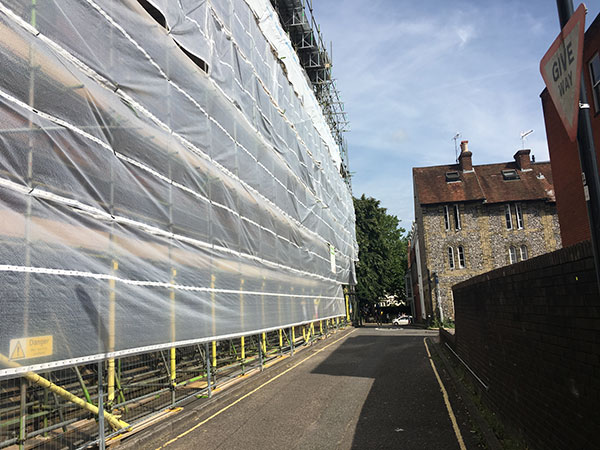In the vibrant realm of city development, commercial scaffolding stands as a fundamental foundation for efficient construction and renovation projects. As city skylines continue to evolve, the need for creative scaffolding solutions has almost never been more important. This article examines the multiple aspects of commercial scaffolding, discussing its value, varieties, and how it can considerably enhance safety and efficiency at job sites.
From high-rise buildings to retail outlets and large facilities, comprehending the role of scaffolding is crucial for any construction practitioner. We will examine how commercial scaffolding not only upholds structural integrity but also affirms compliance with security regulations, leading you through the fundamentals of permits, inspections, and training obligations. Join us as we discover the key elements that make scaffolding an indispensable tool in modern construction endeavors.
Comprehending Commercial Scaffolding
Corporate scaffolding is a vital aspect in the erection and refurbishment of structures, providing a transitory framework that supports workers and materials. It enables for more secure access to tall or hard-to-reach areas during multiple tasks, from new builds to comprehensive renovations. As urban spaces grow ever more crowded, the need for bespoke scaffolding options has surged, underscoring the importance for thoughtful planning and architecture.
There are several forms of scaffolding utilized in commercial projects, including frame setups, modular setups, and suspension scaffolding, each tailored to precise functions and environments. Frame scaffolding is one of the most common options for its adaptability and straightforward assembly. Modular systems, on the contrastingly, is valued for its flexibility and convenience of transport. Understanding the different choices available is essential for selecting the most suitable solution that fits the unique demands and constraints of a project.
Security and adherence in corporate scaffolding cannot be underemphasized. Complying to Occupational Safety and Health Administration (OSHA) regulations is vital for securing a safe job site, as scaffolding can pose significant risks if not properly constructed or cared for. Regular inspections and extensive training for all crew members are necessary to reduce risks, ensuring a protected work environment while enhancing overall task efficiency.
Safety and Compliance in Scaffold Construction
Security and adherence are essential aspects of industrial scaffold construction, ensuring that employees can operate without hazard while complying with regulatory standards. The Occupational Safety and Health Administration sets the regulations that regulate the construction, operation, and maintenance of scaffolds. Contractors must ensure that all scaffolding equipment meets OSHA guidelines, offering the necessary safety measures for workers at elevated levels. Ongoing education and updates on safety protocols are crucial to maintaining adherence and fostering a environment of security on-site.

Modern scaffold systems also improve safety, incorporating features such as guardrails, secure access points, and non-slip surfaces. Compliance with safety regulations not just safeguards workers but also reduces potential liabilities for businesses. Efficient safety practices includes performing routine inspections and resolving any risks swiftly. By emphasizing safety and compliance, organizations foster a safe environment that can greatly increase employee satisfaction and productivity while preventing costly incidents.
Committing in professional scaffolding services guarantees that security and compliance are proficiently managed. Experienced scaffolding firms offer knowledge of standards and effective methods to the project, ensuring that all aspects of scaffold setup and upkeep are meticulously adhered to. Commercial Scaffolding In Rochester with professionals not only reduces the risk of incidents but also ensures that projects run smoothly and efficiently, satisfying crucial timeframes without compromising security requirements.
Organizing and Overseeing Scaffolding Projects
Effective preparation is crucial for the efficient execution of scaffolding projects. Start by evaluating the project’s particular needs, such as the size of effort, type of building, and location conditions. Consult with important stakeholders to establish logistical needs such as delivery times, site entry points, and the configuration of support systems. This preliminary groundwork helps create a clear schedule and financial plan, minimizing delays and confirming that resources are distributed effectively.
Once the planning phase is complete, focus on the management aspect to confirm seamless operations on-site. Regular dialogue with your scaffolding crew, site managers, and other contractors is essential for addressing any challenges that may arise during the building process. Utilizing project management software can streamline task assignments, monitor progress, and manage deadlines successfully. Additionally, designating clear roles and duties within the crew can enhance accountability and foster teamwork.
Safety must remain a top focus throughout the support assignment. Establish a detailed safety program and perform regular training courses to make sure that all employees are knowledgeable with procedures and preferred practices. Carrying out routine safety checks will help identify potential hazards and confirm compliance with OSHA regulations. By creating a culture of protection and awareness, you promote an environment that protects workers and promotes efficiency during the full scaffolding process.
